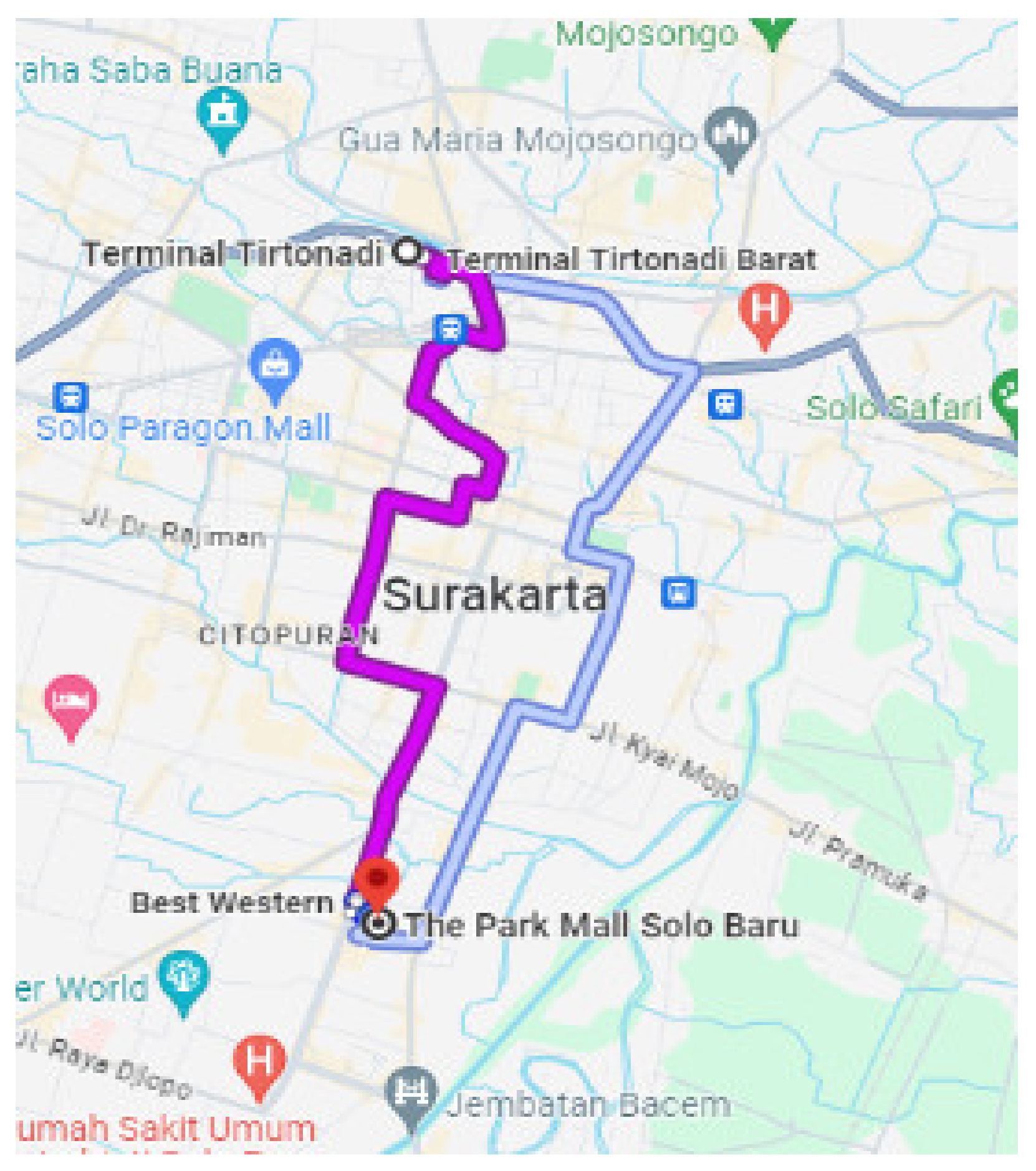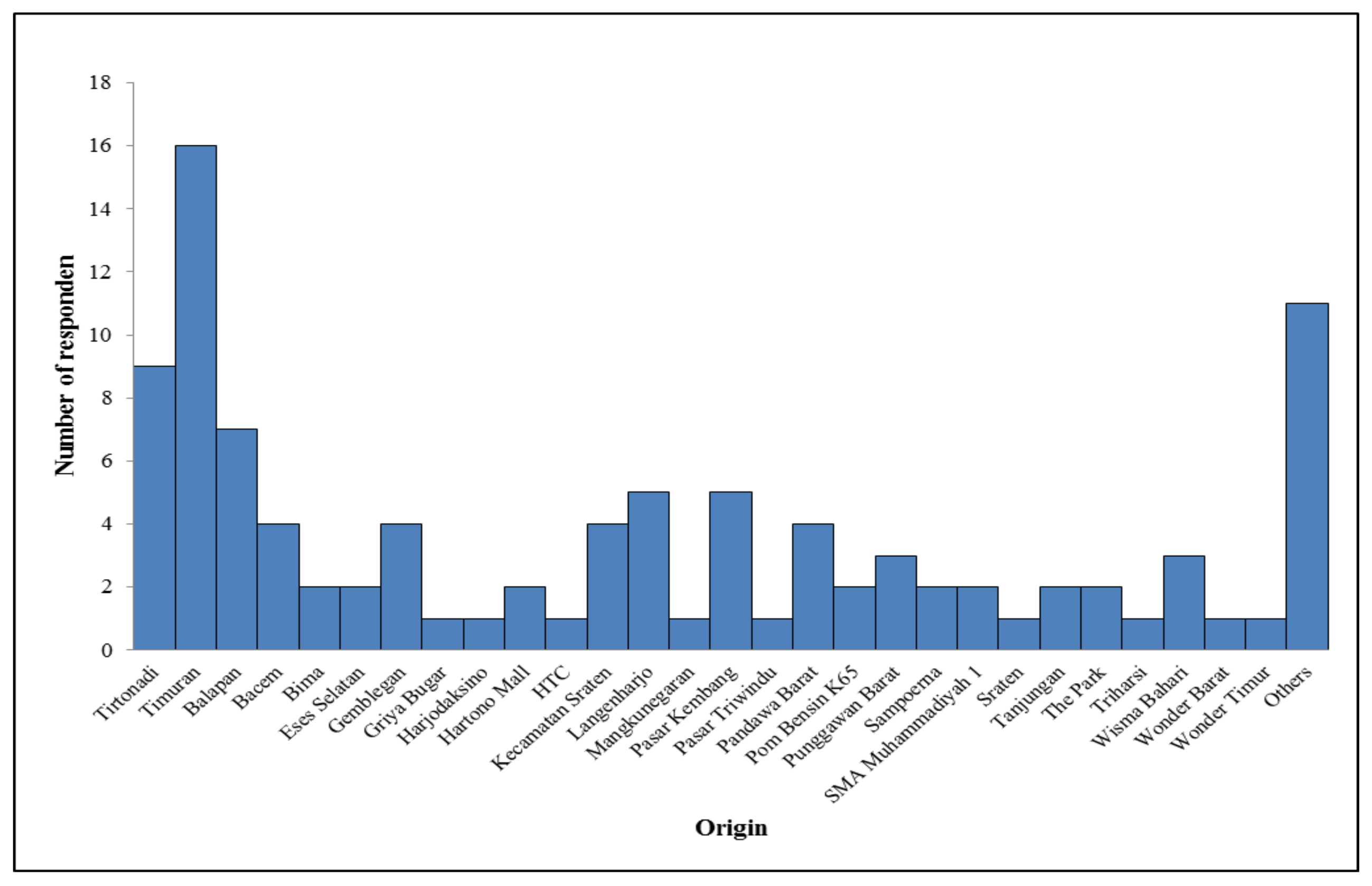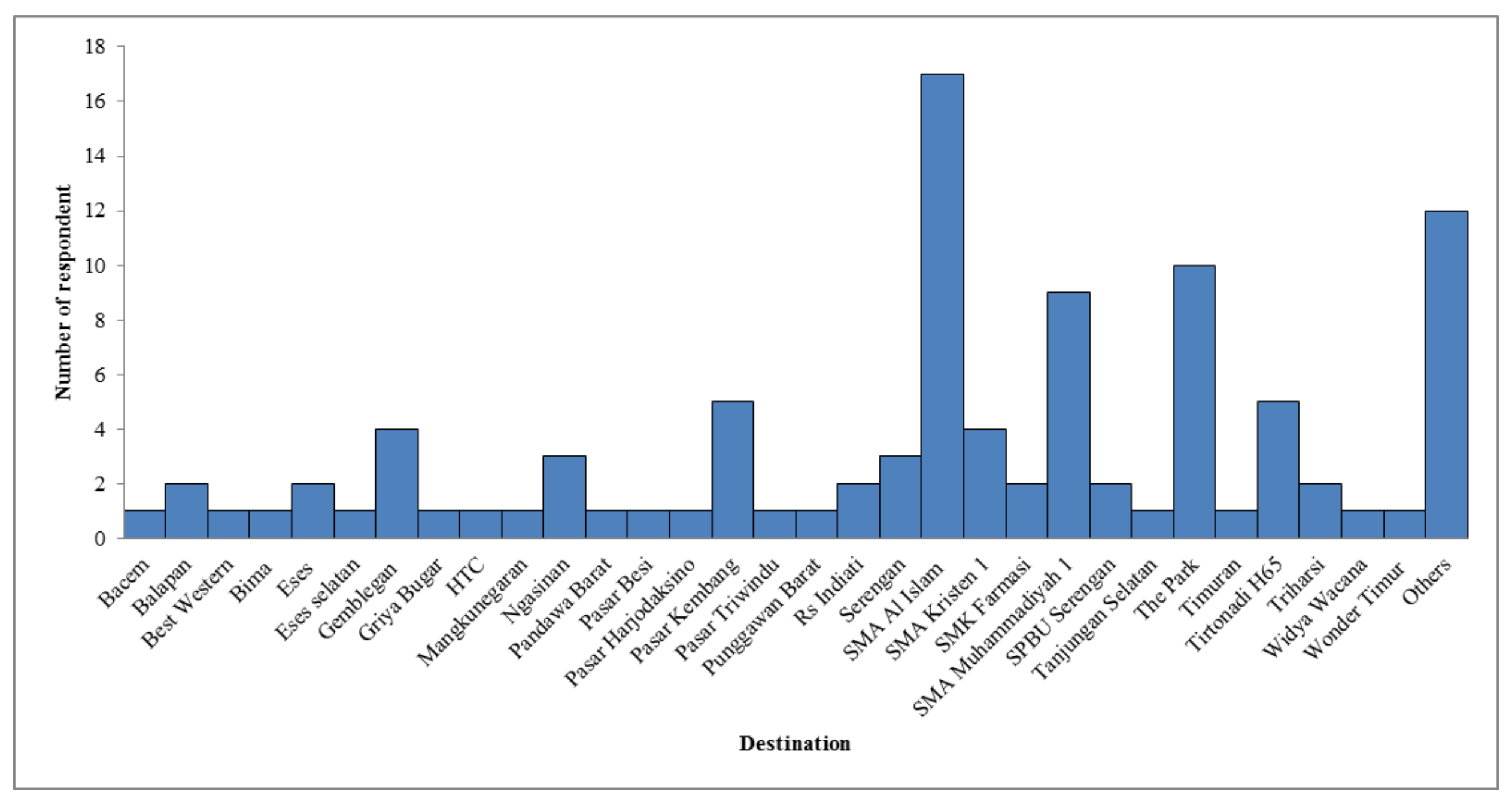Performance Analysis of Batik Solo Trans Corridor-6 Services †
Abstract
1. Introduction
2. Research Methods
2.1. Operational Performance
2.2. Satisfaction Level Assessment
3. Result and Discussion
3.1. Passenger Characteristics
3.2. Operational Performance
3.3. Passenger Satisfaction Level
4. Conclusions
Author Contributions
Funding
Institutional Review Board Statement
Informed Consent Statement
Data Availability Statement
Acknowledgments
Conflicts of Interest
References
- Tamin, O.Z. Perencanaan dan Pemodelan Transportasi [Transport Planning and Modeling]; Penerbit Institut Teknologi Bandung: Bandung, Indonesia, 2000. [Google Scholar]
- Lanori, T.; Supriyanto, B.H. Problems of the Impact of Modernization of Indonesia’s Public Transportation Equipment System. Int. J. Soc. Sci. 2023, 2, 2163–2176. [Google Scholar] [CrossRef]
- Kwarcinski, T. The Influence of Transport Infrastructure Development on Transport Accessibility of Rural Areas in Poland. Eur. Res. Stud. J. 2021, XXIV, 894–904. [Google Scholar] [CrossRef] [PubMed]
- Rodrique, J.-P.; Notteboom, T. The Geography of Transport Systems [Internet]; Rout: New York, NY, USA, 2020; Available online: https://transportgeography.org/contents/chapter3/transportation-and-economic-development/ (accessed on 20 January 2024).
- Qiao, W.; Huang, X. How Does Transportation Development Affect Environmental Performance? Evidence from Hainan Province, China. Cities 2022, 129, 103835. [Google Scholar] [CrossRef]
- Steffen WSchuckmann Gnatzy, T.; Darkow, I.-L.; von der Gracht, H.A. Analysis of Factors Influencing the Development of Transport Infrastructure until the Year 2020—A Delphi based Schenario Study. Technol. Forecast. Soc. Change 2012, 79, 1373–1387. [Google Scholar]
- Aurarisa, I.; Yulianto, B.; Mahmudah, A.M.H. Analisis Tarif dan Load Factor Bus Batik Solo Trans Koridor 4 Pada Masa Pandemi COVID-19 [Analysis of Fare and Load Factor for Batik Solo Trans Corridor-4 during The COVID-19 Pandemic]. J. Matriks Tek. Sipil 2022, 10, 358–366. [Google Scholar] [CrossRef]
- GRI. Undang-Undang Republik Indonesia, Nomor 22, Tentang Lalu Lintas dan Angkutan Jalan [Republic of Indonesia Act, Number 22, Concerning Road Traffic and Transportation]; Government of Republic of Indonesia: Jakarta, Indonesia, 2009. [Google Scholar]
- MoT. Peraturan Menteri Perhubungan Nomor PM 15 Tahun 2019 Tentang Penyelenggaraan Angkutan Orang Dengan Kendaraan Bermotor Umum Dalam Trayek [Minister of Transportation Regulation Number PM 15 of 2019 Concerning Organizing Passenger Transport with Public Motor]; MoT: Jakarta, Indonesia, 2019. [Google Scholar]
- Prakoso, F.A. Evaluasi Kinerja Pelayanan Angkutan Umum Di Kabupaten Tegal: Studi Kasus Angkutan Pedesaan Trayek Slawi—Larangan [Evaluation of the Performance of Public Transport Services in Tegal Regency: Case Study of Rural Transport Slawi- Larangan]; Universitas Pancasakti Tegal: Tegal, Indonesia, 2020. [Google Scholar]
- BPS Surakarta. Pertumbuhan Ekonomi Kota Surakarta Tahun 2022 [Economic Growth of the City of Surakarta in 2022]; Berita Resmi Statistik; BPS Surakarta: Surakarta, Indonesia, 2023; pp. 1–10. [Google Scholar]
- BPS Surakarta. Jumlah Penduduk Menurut Kecamatan (Jiwa), 2020–2022 [Internet]. Badan Pusat Statistik, Kota Surakarta. 2022. Available online: https://surakartakota.bps.go.id/indicator/12/313/1/jumlah-penduduk-menurut-kecamatan-kota-surakarta (accessed on 17 January 2024).
- BPS. Luas Wilayah Menurut Kabupaten/Kota 2019–2021 [Internet]. BPS Jateng. 2021. Available online: https://jateng.bps.go.id/indicator/153/613/1/luas-wilayah-menurut-kabupaten-kota.html (accessed on 20 January 2024).
- Rahmawati, F. Analisis Tarif Berdasarkan Biaya Operasional Kendaraan (BOK), Ability To Pay (ATP), dan Willingness To Pay (WTP) Bus Batik Solo Trans Ppda Masa Pandemi COVID-19: Studi Kasus Koridor 1 & 2 [Fare Analysis Based on Vehicle Operating Cost (VOC), Ability to Pa]; Universitas Sebelas Maret Surakarta: Surakarta, Indonesia, 2021. [Google Scholar]
- Levinson, D. Perspectives on Efficiency in Transportation. Int. J. Transp. Manag. 2003, 1, 145–155. Available online: https://www.sciencedirect.com/science/article/pii/S1471405104000035 (accessed on 20 January 2024). [CrossRef]
- Istianto, B.; Djajasinga, N. Analysis of the Performance of Public Transportation Services in the Traffic Perspective of the City of Bandung, West Java, Indonesia. Rev. Int. Geogr. Educ. 2021, 11, 3090–3102. [Google Scholar]
- MoT. Peraturan Menteri Perhubungan Nomor 98 Tahun 2013 Tentang Standar Pelayanan Minimal Angkutan Orang Dengan Kendaraan Bermotor Umum Dalam Trayek [Minister of Transportation Regulation Number 98 of 2013 Concerning Minimum Service Standard for Passenger Trans]; MoT: Jakarta, Indonesia, 2013. [Google Scholar]
- Avisha, F. Evaluasi Tarif Angkutan Umum Berdasarkan Biaya Operasional Kendaraan (BOK), Ability to Pay (ATP) dan Willingness to Pay (WTP) Angkutan Bus Antar Kota CV Sempati Star; Universitas Muhammadiyah Sumatera Utara: Medan, Indonesia, 2019. [Google Scholar]
- MoT. Program TEMAN BUS Telah Melayani 1,5 Juta Lebih Perjalanan [TEMAN BUS Application has Served More Than 1.5 Millios Trips] [Internet]. Ministry of Transportation. 2020. Available online: https://portal.dephub.go.id/post/read/program-teman-bus-telah-layani-1,5-juta-lebih-perjalanan (accessed on 18 January 2024).
- Ginting, V.D.; Putra, I.K.K.; Maharani, N.P.A.; Kusuma, R.A.F.; Dwipayana, A.D. Integrasi Pelayanan Teman Bus Terhadap Kawasan Strategis Pariwisata Nasional di Bali. J. Rekayasa Sipil Dan Lingkung. 2022, 4, 176–190. [Google Scholar] [CrossRef]
- Google. Terminal Tirtonadi—The Park Mall Solo Baru [Internet]. Google Maps. Available online: https://www.google.com/maps/dir/Terminal+Tirtonadi,+Jalan+Ahmad+Yani,+Manahan,+Kota+Surakarta,+Jawa+Tengah/The+Park+Mall+Solo+Baru,+Jl.+Ir.+Soekarno,+Dusun+II,+Madegondo,+Kec.+Grogol,+Kabupaten+Sukoharjo,+Jawa+Tengah+57552/@-7.5705323,110.8241204,13z/data=!4m14!4m13!1m5!1m1!1s0x2e7a1699c370c19d:0xcc43da4b051938d0!2m2!1d110.8186087!2d-7.5515164!1m5!1m1!1s0x2e7a170b4060aab1:0x5b04edc33af1a382!2m2!1d110.8166993!2d-7.5988324!3e3?entry=ttu (accessed on 20 January 2024).
- DGoLT. Pedoman Teknis Penyelenggaraan Angkutan Penumpang Umum di Wilayah Perkotaan dalam Trayek Tetap dan Teratur [Technical Guidelines for Organizing Public Passenger Transport in Urban Areas on Fixed and Regular Routes]; SK.687/AJ.206/DRJD/2002; Directorat General of Land Transportation: Jakarta, Indonesia, 2002. [Google Scholar]
- MoT. Peraturan Menteri Perhubungan Republik Indonesia Nomor 10 Tahun 2012 tentang Standar Pelayanan Minimal Angkutan Massal Berbasis Jalan [Indonesian Minister of Transportation Regulation Number 10 of 2012 concerning Minimum Service Standards for Road-Based M]; MoT: Jakarta, Indonesia, 2012. [Google Scholar]
- Gwilliam, K.M. Cities on the Move: A World Bank Urban Transport Strategy Review [Internet]; World Bank Group: Washington, DC, USA, 2002; Available online: http://documents.worldbank.org/curated/en/928301468762905413/Cities-on-the-Move-A-World-Bank-Urban-Transport-Strategy-Review (accessed on 20 January 2024).
- Hasanah, R.; Kusumawati, W.D. Integrative Science Education and Teaching Activity Journal Development of Ethnoscience-Based Digital Teaching Materials in Authentic Jember Patrol Music in Sound Sub Materials for Students in Junior High School. Integr. Sci. Educ. Teach. Act. 2022, 3, 56–69. [Google Scholar]



| Question Number | rcalculate | rtable | Mark |
|---|---|---|---|
| 1 | 0.701 | 0.355 | Valid |
| 2 | 0.845 | 0.355 | Valid |
| 3 | 0.543 | 0.355 | Valid |
| 4 | 0.670 | 0.355 | Valid |
| 5 | 0.527 | 0.355 | Valid |
| 6 | 0.725 | 0.355 | Valid |
| 7 | 0.594 | 0.355 | Valid |
| 8 | 0.584 | 0.355 | Valid |
| 9 | 0.724 | 0.355 | Valid |
| 10 | 0.483 | 0.355 | Valid |
| Information | RAL (%) |
|---|---|
| Extremely poor | 0–20 |
| Poor | 21–40 |
| Moderate | 41–60 |
| Good | 61–80 |
| Extremely good | 81–100 |
| Characteristic | Respondents | |
|---|---|---|
| Number | (%) | |
| Gender | ||
| Male | 39 | 39 |
| Female | 61 | 61 |
| Age | ||
| 15–25 | 44 | 44 |
| 26–36 | 23 | 23 |
| 37–47 | 16 | 16 |
| 48–58 | 12 | 12 |
| 59–70 | 5 | 5 |
| Occupation | ||
| Student | 40 | 40 |
| Merchant | 19 | 19 |
| Private employee | 23 | 23 |
| Government employee | 6 | 6 |
| Others | 12 | 12 |
| Frequent | ||
| 1 | 78 | 78 |
| 2 | 20 | 20 |
| 3 | 2 | 2 |
| Previous mode used | ||
| Walking | 36 | 36 |
| Private mode | 36 | 36 |
| Others | 28 | 28 |
| Indicator | Average | Standard | Marks of the Standard | ||
|---|---|---|---|---|---|
| SK. 687 (2002) | PM 10 (2012) | World Bank | |||
| Load factor (%) | 19 | >70 | Did not meet | ||
| Headway (minutes) | 5.78 | Ideal 5–10 Peak 2–5 | Average 5–10 Maximum 10–20 | Meet | |
| Travel time (hours) | 36.85 | Average 1.0–1.5, Maximum 2–3 | Average 1.0–1.5 Maximum 2–3 | Did not meet | |
| Travel speed (km/hour) | 25.47 | Maximum 30 | Peak 30 Off peak 60 | High density 10–12, Low density 25 | Meet |
| Stopped time (seconds) | 6 | Peak 45 Off peak 60 | Meet | ||
| No | Criteria | Extremely Good | Good | Moderate | Poor | Extremely Poor | RAL (%) |
|---|---|---|---|---|---|---|---|
| 1 | Timeliness | 16 | 64 | 14 | 6 | 0 | 78 |
| 2 | Friendly officer | 20 | 61 | 18 | 1 | 0 | 80 |
| 3 | Comfortable seat | 12 | 62 | 26 | 0 | 0 | 77.2 |
| 4 | Bus stop information | 17 | 43 | 38 | 1 | 1 | 74.8 |
| 5 | Officer alertness | 13 | 43 | 37 | 7 | 0 | 72.4 |
| 6 | Quality of payment services | 18 | 45 | 36 | 1 | 0 | 76 |
| 7 | Air conditioning | 17 | 58 | 25 | 0 | 0 | 78.4 |
| 8 | Cleanliness and tidiness | 15 | 64 | 20 | 1 | 0 | 78.6 |
| 9 | Access for boarding and aligning | 16 | 60 | 23 | 1 | 0 | 78.2 |
| 10 | Interior and exterior appearance | 10 | 60 | 21 | 9 | 0 | 74.2 |
| Average | 76.78 | ||||||
Disclaimer/Publisher’s Note: The statements, opinions and data contained in all publications are solely those of the individual author(s) and contributor(s) and not of MDPI and/or the editor(s). MDPI and/or the editor(s) disclaim responsibility for any injury to people or property resulting from any ideas, methods, instructions or products referred to in the content. |
© 2024 by the authors. Licensee MDPI, Basel, Switzerland. This article is an open access article distributed under the terms and conditions of the Creative Commons Attribution (CC BY) license (https://creativecommons.org/licenses/by/4.0/).
Share and Cite
Hidayati, N.; Damarjati, I.; Mulyono, G.S.; Magfirona, A. Performance Analysis of Batik Solo Trans Corridor-6 Services. Eng. Proc. 2024, 63, 9. https://doi.org/10.3390/engproc2024063009
Hidayati N, Damarjati I, Mulyono GS, Magfirona A. Performance Analysis of Batik Solo Trans Corridor-6 Services. Engineering Proceedings. 2024; 63(1):9. https://doi.org/10.3390/engproc2024063009
Chicago/Turabian StyleHidayati, Nurul, Ilham Damarjati, Gotot S. Mulyono, and Alfia Magfirona. 2024. "Performance Analysis of Batik Solo Trans Corridor-6 Services" Engineering Proceedings 63, no. 1: 9. https://doi.org/10.3390/engproc2024063009
APA StyleHidayati, N., Damarjati, I., Mulyono, G. S., & Magfirona, A. (2024). Performance Analysis of Batik Solo Trans Corridor-6 Services. Engineering Proceedings, 63(1), 9. https://doi.org/10.3390/engproc2024063009






